MENU
MENU
Tea production area: Chiang Rai, Chiang Mai, Mae Hong Son, Lampang and Phrae
Type of tea: Green tea, oolong tea, black tea, flavored tea, Miang (post-fermented tea), etc.
Tea is cultivated in northern Thailand and various types of teas are produced including green tea, black tea, oolong tea, flavored tea, etc.
In northern Thailand, post-fermented tea leaves “Miang” have been eaten since long ago.
There are tea gardens for tourists in northern Thailand.
In Thailand, people prefer to drink sweet tea. Sweet green tea and sweet black tea sold in plastic bottles can be found in the supermarkets.

Choui Fong Tea Garden in Chiang Rai (December 2018)
Wild tea
Monsoon Tea House in Chiang Mai produces a variety of flavored teas using leaves picked from wild tea plants. The teahouse has a space where you can enjoy tea and food made using tea leaves, such as tea leaf salad, fried chicken with fermented leaf paste, etc.
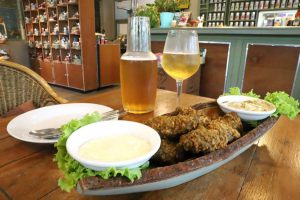
Moonsoon Tea House (December 2018)
Deep-Fried Chicken with Fermented Tea Leaf Paste & Tropical sunset

Moonsoon Tea House (December 2018)
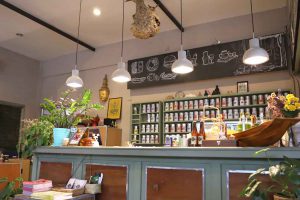
Moonsoon Tea House (December 2018)
Tourist tea gardens
There are many tea gardens for tourists to visit in Thailand.
Choui Fong Tea Garden and Singha Park in Chiang Rai are popular tourist spots for local people. Both gardens have a large site where there are tea fields, shops, restaurants, cafés, etc. Visitors can walk through the tea fields freely. Singha Park is run by the Singha Beer company.

Choui Fong Tea Garden in Chiang Rai (December 2018)
-300x111.jpg)
Singha Park (December 2018)
Araksa in Chiang Mai has a beautiful tea garden. Visitors can have tea-themed experiences such as picking tea leaves, drinking tea, and making tea using a traditional cauldron. Lunch is also served, by advance reservation.

ARAKSA Tea Garden (January 2019)
Post-fermented tea leaves Miang
Miang is a highly post-fermented tea leaf that has been eaten in northern Thailand in places such as Chiang Mai since long ago. Miang is a kind of pickled tea leaf. Miang has a potent fermented smell and a strong sourness and bitterness.
Wrap a pinch of salt or crushed peanuts with a piece of Miang tea leaf, and eat it.
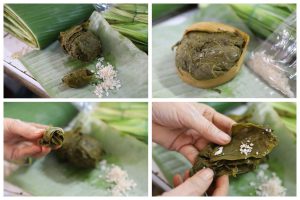
Miang sold at Siriwattana market in Chiang Mai (December 2018)
The producing method of Miang is simple. Steamed tea leaves are pickled with salt water in a wooden or plastic bucket. Then, the bucket is covered and a stone weight is placed on it. The preservation process takes about half a year.
The longer the period, the higher the degree of fermentation.
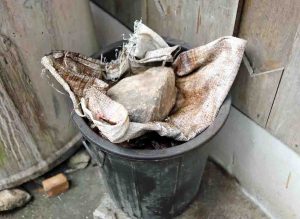
Miang in Mae Kampong Village (December 2018)
Historically, steamed tea leaves were put in a bamboo basket lined with banana leaves, and sealed with pork fat. This basket was then buried in the ground to ferment the tea leaves. Wild tea leaves are used to produce Miang in Mae Kampong Village.
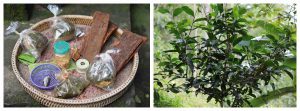
Miang and a wild tea plant in Mae Kampong Village (December 2018)
Related article on the site: “Miang“
Reference:
The Food and Agriculture Organization of the United Nations
http://www.fao.org/home/en/
FAOSTAT http://www.fao.org/faostat/en/#home Tea
大森正司、阿南豊正、伊勢村護、加藤みゆき、滝口明子、中村羊一郎編(2017) 茶の事典 初版第一刷 朝倉書店
Choui Fong Tea Garden http://www.chouifongtea.com
Araksa tea garden http://www.araksatea.com
Singha Park Chiang Rai https://www.singhapark.com/
Moonsoon Tea House https://monsoon-tea-company.com
*The information provided on this site may be updated. If you find any information in this article that is incorrect, out of date, or incomplete, please contact CHAMART.
*The site does not describe all “Teas of Japan” or all “Teas of the World”. Additionally, each article expresses the writer’s personal experience and feelings.